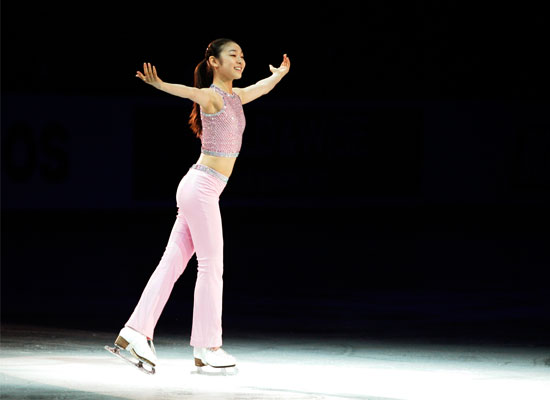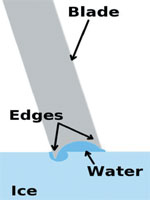
Short track skating has fulfilled many Koreans every time the Winter Olympic Games were held. Skating was a national item to gain gold medals from the competition. But unlike the past, there is now a national interest in figure skating. Figure skating fever was brought by Korea's most beloved figure skating heroine Kim Yu-na. This is because of her recent glittering gold medal performance in the ISU (International Skating Union) Grand Prix of Figure Skating finals in Torino, Italy. People have a constant interest in how she jumps on the ice, and of course how cute she is on the ice.
What is Figure Skating?
Why do we call it "Figure" skating? Figure skating in the first place was drawing certain diagrams with the lines made by the blades. From the concept of drawing figures, it became a general term of figure skating performed in individuals, pairs, or groups perform spins, turns, and other choreography on ice.
Figure skaters compete at various levels from beginners up to the Olympic level (senior), and in local, national, and international competitions. The International Skating Union (ISU) regulates international figure skating judging and competitions. Figure skating is an official event in the Winter Olympic Games
Figure skating has its value because of its artistry and association with show business. Major competitions generally include exhibitions at the end in which the top-placing skaters perform for the audience by showing their various skills. Many skaters, both during and after their competitive careers, also skate in ice skating exhibitions or shows which run during the competitive season and the off-season.
In Korea, however, figure skating was first introduced in 1924 by Lee Il. The very first stadium was established in 1964 at Dongdaemun. Since 2003, there are more than 1,072 players in speed skating and 237 players in figure skating.
Overview on Scientific Facts on the Ice Surface
What connections are there between the ice and the skater's blades? This is the main reason why we are attracted to Kim Yu-na every time she jumps and turns on the field.
In general skating, including all categories performed over the ice, ice is not inherently slippery, it is several scientific facts that cause skaters to slide and allow them to skate upon it. When skating, one is not actually skating on the solid ice, but water in its liquid form. The reason for this is that ice will instantly melt when pressure is applied to it, because according to experimental values, is that greater the pressure on a substance, lower its freezing point will be.
Thus, when the pressure is increased on ice at -2℃, which at sea level has a freezing point of 0℃, the new freeing point will be below -2℃, if enough pressure is applied. A person? weight is not enough to melt sufficient ice under their own shoes, thus the ice skate was invented. The ice skate puts the weight of the skater on a very narrow area, thus the sharp skate blade, which causes the ice under the blade to melt because the person's weight is sufficient to melt the ice in that area. This allows the skater to glide on a layer of water between the blade and the ice. Thus, a skater's blade does not cut through ice, but melts through ice to allow a skater to skate.

Two Important Requirements of Figure Skating
Then, how can Kim Yu-na show us her fairy tale so beautifully? The two important factors which are counted most by judges are jumping and landing which composes 90 percent of their performances. Then, how can they perform longer and more gorgeously? Here is the answer; it can also interpreted by physics.
"The Preservation of Momentum"can be applied in this phenomenon. To spin fast, or for a long time, the skater must develop a large amount of angular momentum which determines the speed of rotation during a skater's jump. Oh Hye-keun, professor of Applied Physics of Hanyang University, gave his comments on this. "To stay longer in the air, you need to understand a little of physics. The momentum is directly proportional to mass and velocity. And those two are inverse proportional. So in a rotational system like a spinning plate, when mass is conentrated at the center, the virtual inertia become smaller and velocity grows. It can be explained by the Law of Preservation of Momentum." This means that if you increase your moment of inertia by raising your arms, your angular velocity might decrease in the opposite direction to keep the angular momentum constant. As you spin, raise your arms out to the side, and then lower them back down. When you raised your arms, you should have slowed down with no exception.
Also, stable landing is required to prevent injury and improve the quality of an act. And it is the reason why skaters shrink while they rotate because of the fact that lower Center of Mass (COM) guarantees a stable landing which is necessary for skater to be protected from injuries. Professor Oh also mentioned "Lower center of mass means small amount of potential energy and greater kinetic energy which triggers an increase in velocity. Momentum is also preserved when no external force is involved and by the law of preservation of momentum"
When landing, as the toe part of skate lands prior to any part, most skaters concentrate their weight on the toes while they land. Regarding this Professor Oh added, "In fact, an increase in time shortens shock power, but what protects skaters from injury mostly relates with force (shock power divided by time)." When the whole blade of skate lands at once on the ice, it causes tremendous amount of force, but toe-first landings hit the face with less power, first from toe part to heel. This weakens the force which is fully influential for player to finish their acting without getting hurt. The same principal can be applied to a paratrooper who prefers snowy powder than a bare one when they land from the air. Increase in landing time causes less hurts.
How to Recognize an Axel Jump
Raising more interest in figure skating, there is a jump called "Axel jump" which is popular to skating fans. This the reason why figure skating became so familiar with Kim Yu-na and her rival, Mao Asada. Asada's triple axel which Kim could not do at that time got the spotlight even before the two players participated in the competition. The "Axel" is a jump with a forward take-off. It is named after the Norwegian skater Axel Paulsen, who first performed the jump in 1882. An "Axel jump" has an extra half rotation in the air triggered by its forward take-off. The "Axel" can be done as a double jump with 2 1/2 rotations, or as a triple with 3 1/2 rotations.
A New Understanding of Skating
Now, for people who want to discover figure skating secrets, the secret has been revealed. Even though players like Kim Yu-na, Mao Asada do act like real fairy queens in the stadium, there is a royal and exact way to be like them. As mentioned above, those simple principals are explained by physics. Lower Center of Mass rotates fast and proves no hurt and understanding of angular momentum helps player to stay longer in the air. Eureka in physics moves judges, audience, figure skating fans and you can be one.


